Home Fire Safety Guide
You have less than two minutes to get out of a burning home before it’s engulfed in flames and smoke.¹ Since there’s so little time to think or act in the moment, it’s vital to prepare yourself with home fire safety education before you ever have to face it in real life.
What this guide covers
Home fire safety statistics
We hope that a house fire won’t ever happen to you, but it could. More than 27% of reported fires are in homes.¹ Though the risk of a house fire depends on many factors, you can still learn a lot about the risks from general statistics.
Most common house fire causes
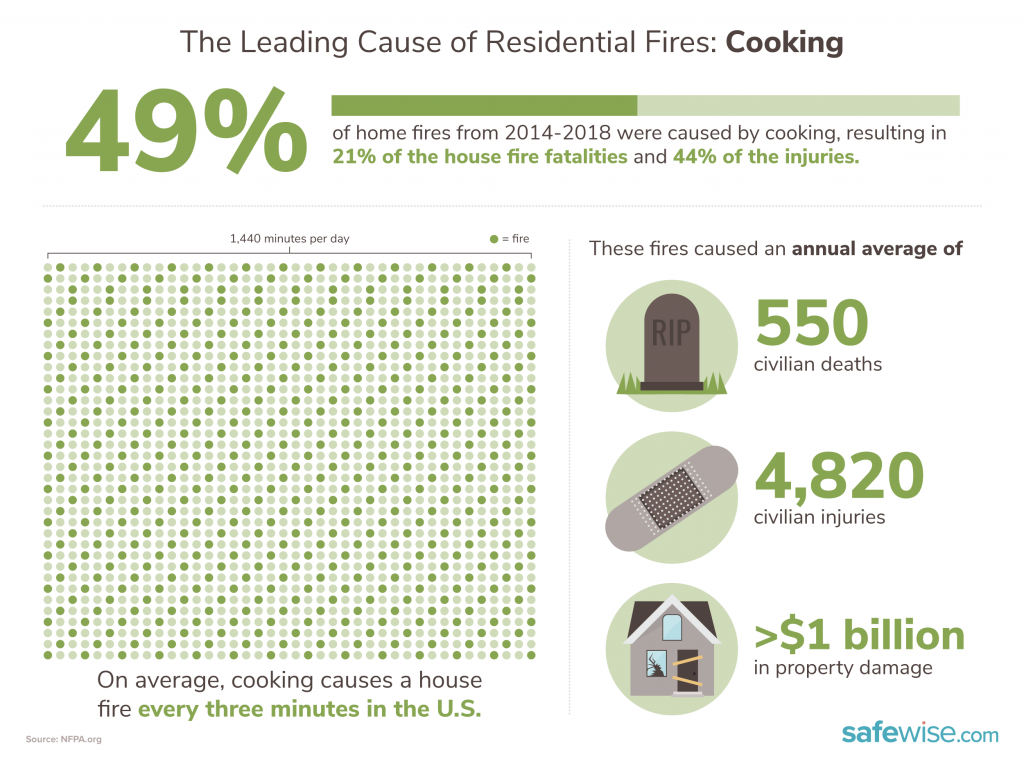
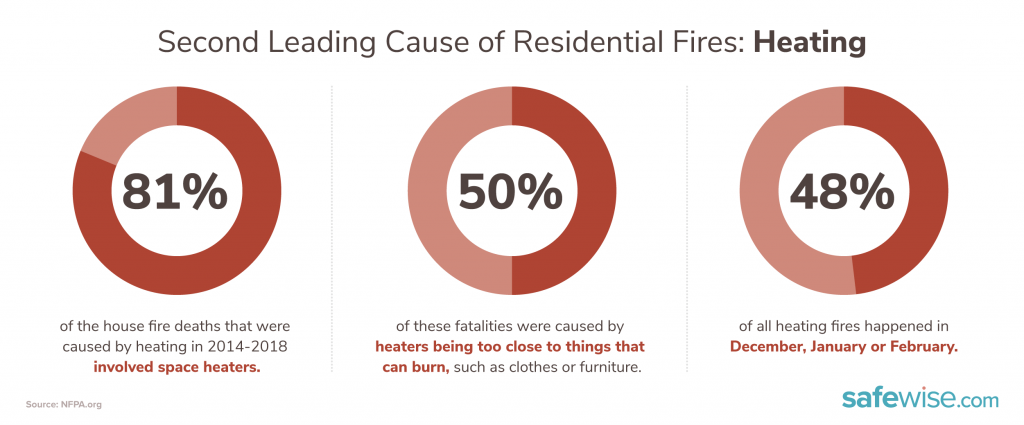
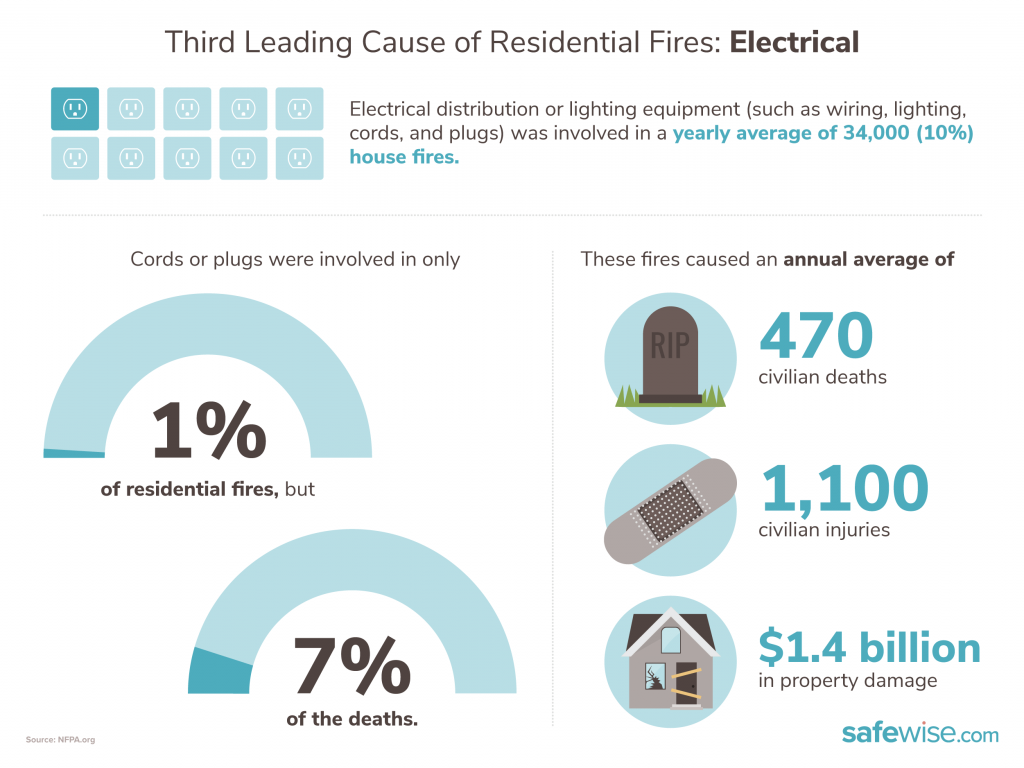
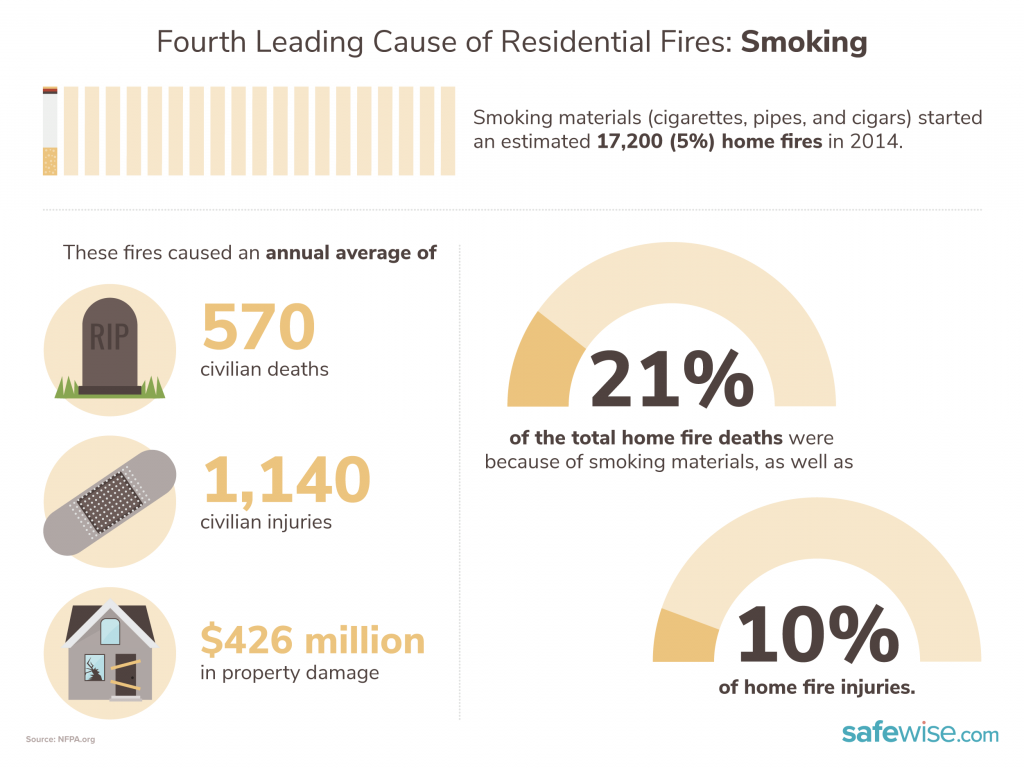
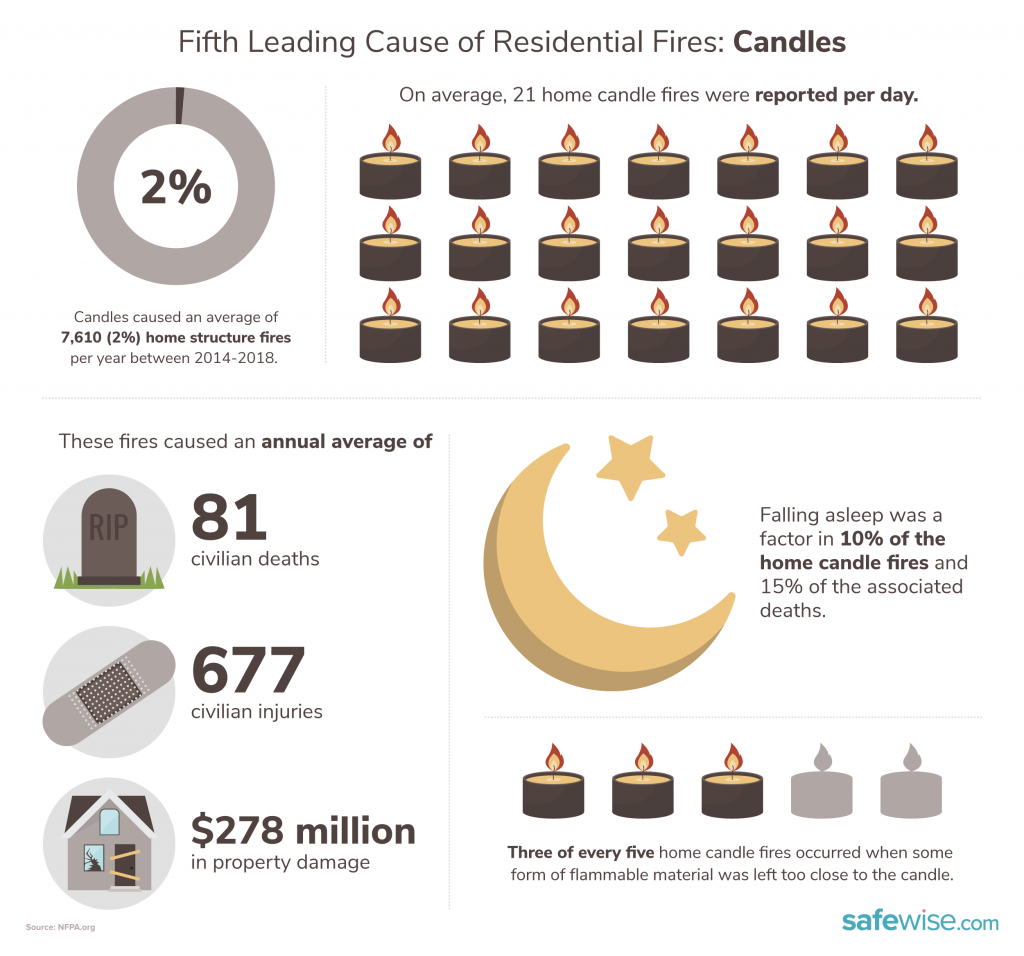
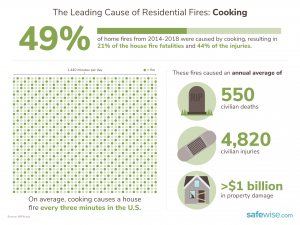
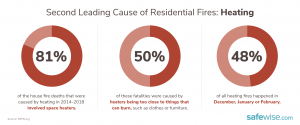
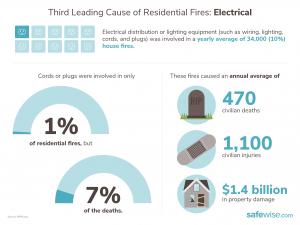
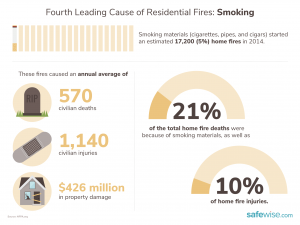
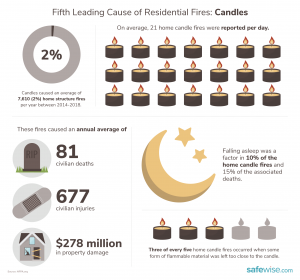
Not surprisingly, if something can heat up, then it has the potential to start a fire. Cooking is the most common cause of house fires, but there are several other culprits. According to the National Fire Protection Association (NFPA) there are five top fire causes:
This full list of places where fires occur in the home can help you prevent potential fire hazards.
Most common times for house fires
Home fires are more common during the fall and winter, with the highest numbers of fires in December and January. This risk might heighten when people light more candles, use fireplaces or space heaters, or don’t water the Christmas tree.
From day to day, fires seem to start when people are more likely at home. House fires commonly occur on a Saturday or Sunday and between 6:00 and 7:00 p.m.—times that people are often home.2
House fire deaths and costs
Smoking kills in more ways than you may think. It is the leading cause of home fire deaths, killing an average of 590 people per year.3 Overall, house fires are responsible for approximately 2,620 deaths each year and cause around $7.2 billion in property damage each year.4
Need more stats? The NFPA has a tool to compare fire death rates between various states.
Learn more about home safety risks from our safety stats and facts resource.
How to prevent house fires
The best fire is one that doesn’t happen. Here are our top fire prevention tips:
- Buy a fire extinguisher. Then, learn how to use your fire extinguisher.
- Teach children the basics of fire safety and how to prevent fires.
- Always keep matches, lighters, and other fire hazards out of the reach of children.
- Keep flammable items at least three feet away from anything hot. (e.g. fireplaces, space heaters, and ovens).
- Only smoke outside.
- Always stay in the kitchen while cooking in case something catches fire.
- Remember to shut off your stove after cooking.
- Extinguish controlled fires completely. This includes fires in fireplaces and firepits.
- Don’t start a fire outdoors if you live in a dry climate. If you do, make sure to spray down the surrounding area in case a spark lands outside of your fire pit.
Learn about electrical fires, common electrical hazards, and how to fix them.
Print out our room-by-room fire prevention checklist:
Helpful fire safety products
These fire safety products can help prevent fires from getting out of hand:
- Fire Extinguishers: store a fire extinguisher in your kitchen and on each level of your home, near bedrooms. Find SafeWise’s top fire extinguisher picks here.
- Fire Blanket: use a fire-retardant blanket to extinguish a small fire by smothering it before it has a chance to get any bigger.
- Smoke Detectors: compare top picks in our smoke detectors buyers guide.
- Home Fire Sprinklers: once activated, automatic home fire sprinklers can significantly reduce flames and heat, often long before the fire department can get to your home. Search for companies near you that can install sprinkler systems in your home.
- A Fire Escape Ladder: if you live in a building with more than one level, fire escape ladders can help you quickly and safely escape out a window.
Make a fire safety plan
Emergency escape plans save lives. Do you have one for your home? Knowing what to do in a fire can make getting out safe easier.
First, start by drawing a map of your home including windows, doors, and hallways. Identify main emergency exits like the front and back door. Come up with a primary emergency escape route and then contingency routes to follow if one way is blocked.
Remember, in an actual fire, flames, and smoke can make passageways impassable, so it’s important to think this through when planning an escape route. For instance, if you have upper floor bedrooms, you can buy fire ladders that unravel to help people escape quickly.
Once your fire escape plan is ironed out, try a fire drill. Again, use different scenarios to achieve better preparedness. For starters, have everyone lie in their beds to simulate a night fire. Then, practice escaping from common areas like the kitchen and living room.
Also, consider the fact that smoke can decrease visibility significantly. Try a fire drill in complete darkness or with everyone’s eyes closed. Practice counting doors and sensing your whereabouts by touch instead of sight. The more practice you have in more scenarios, the better prepared everyone will be in an actual emergency.
Print out this form and use it as a guide when making your fire escape plan:
What to do during a house fire
Here are the most important things to do during a house fire:
- Stay calm
- Stay low
- Get others out if you can
- Call 911
Remember, everything can be replaced except for your life. If you remember nothing else from this guide, remember the four steps above. The following tips delve a little deeper into what you should do if there is a fire in your home.
Stay calm and stay low
Above all, stay calm. We know it’s hard with the smoke, heat, and the smoke detector blaring. Panicking can make you forget the steps you need to survive, though.
If there’s already a lot of smoke, stay as low to the floor as possible. Heat rises, so staying low keeps you cooler and keeps you below the smoke so you can breathe easier. If you can’t get below the smoke, cover your mouth with clothing or a towel and crawl on your hands and knees to the nearest exit.
In fires, smoke and heat are often more dangerous than flames. House fires can cause areas near the ground to reach 100℉ and up to 600℉ near eye level. Asphyxiation from smoke and toxins in the air is the leading cause of fire deaths.¹
If you catch fire, the stop, drop, and roll guidelines you learned in school still apply. Stop, drop to the ground, and roll around to smother the fire. Cool any burned skin by pouring water over it for three to five minutes.⁵
Extinguish the fire if you can
If a fire starts in your home, call the fire department immediately while assessing if you can put the blaze out yourself. Go with your gut. If there’s too much smoke and a lot of heat, get yourself to safety.
As long as professional help is on its way, though, you can attempt to use a fire extinguisher to put out small flames. This will prevent the fire from getting worse, if nothing else.
As soon as you realize there’s a fire, let everyone in the home know by yelling “fire” several times as loudly as you can.
Get out
The only non-replaceable items are people and pets. Resist the urge to grab your laptop or jewelry. Instead, attend to family members and pets first. Rank them in order of who needs the most help (e.g. a baby or disabled family member).
If there’s enough time, you can gather important documents like your driver’s license, birth certificate, marriage or divorce certificates, and photo albums. If there isn’t, forget about it. Preserving life is much more important than saving electronics or personal effects.
Don’t walk into any room without touching the doorknobs first. If there is heat, it’s probably not safe to enter. Opening doors can also increase airflow and accelerate the rate the fire spreads. Close the doors behind you as you leave.
Once everyone in your family is out of your house, stay out. Don’t go back inside for anything—it’s too dangerous! The firefighters will be able to go back inside to save anything they can. That’s what they train for, and they have gear to protect themselves.
Also, remember to stay back. Explosions are uncommon but could cause you to become injured if you’re too close.
Never take an elevator during a fire. You could become trapped or suffer a fall if the elevator fails or gives out. Always use the stairs or fire escape instead of an elevator.
What to do if you’re trapped
If you’re trapped in a room during a fire, take a deep breath and remember this:
- Close the door and plug up any cracks or vents with a blanket, clothes, or a towel to keep the smoke out. Wet the cloth you use to plug cracks if you can.
- Call 911 if you have a phone to tell authorities where you are in the building.
- Yell for help if you don’t have a phone.
- Hang a piece of clothing or cloth out the window or yell to alert emergency crews that you’re still in the building.
What to do after a house fire
Before you do anything else, get medical attention for you, your family, and your pets—even if you think everyone is okay. Simply inhaling smoke can endanger you and your furry companions. If you’re unsure if you need medical attention, consult with the first responders on the scene.
After a house fire, it’s normal to feel a lot of emotions, from fear, to shock, to grieving. We know how important it is to take time to process your situation. The American Red Cross offers 24/7 counseling and support for those in distress from a disaster. You can call or text the Disaster Distress Helpline at +1-800-985-5990.
When you’re ready, there are a few things you should do after a house fire:
- Get a fire report, and ask the fire department if your home is safe for you to enter. Also, ask if the utilities are shut off and if they will be turned back on.
- Call the Red Cross if you need help with housing, clothing, food, or getting your medications refilled quickly. You can reach the American Red Cross at +1 (800) 733-2767.
- Secure your home. Nail plywood over broken windows and doors to prevent intruders from entering before you can make repairs.
- Contact your home or rental insurance company. If the fire also damaged your car, don’t forget to call your auto insurer.
- Take inventory. Note everything that you lost for your insurance company.
- Keep track of everything you spend related to the fire and save receipts—such as hotel costs, new clothing purchases, and the cost of the plywood to board up your home. You’ll need receipts for your insurance claim and your income taxes at the end of the year.
Call your mortgage company to inform them of the fire.
National fire safety resources
- FEMA U.S. Fire Statistics
- Fire Safety (National Safety Council)
- National Fire Protection Association
- American Red Cross
- American Red Cross Disaster Recovery Guide
- Home Fire Risk Map
- Wildfire Risk to Communities
- What to Do After a Home Fire
- Insurance Information Institute Wildfire Stats and Facts
- Avoiding Wildfire Damage: A Checklist for Homeowners
- Fire Safety Resources for Kids and Teachers
Local fire safety resources
Click on your state below to see a list of local fire safety and prevention resources.
Fire safety FAQ
What are the four types of fires?
- Class A are paper, cloth, wood, and some plastics fires.
- Class B are flammable liquid fires.
- Class C are electrical fires.
- Class D are flammable metallic substance fires.
What are the four types of fire extinguishers?
- Type A: used only for Class A fires
- Type ABC: used for paper, wood, cloth, and some plastics fires, flammable liquid fires, and electrical fires
- Type BC: used for flammable liquid fires and electrical fires
- Type K: used only for grease fires
What is the first rule of fire safety?
Have a smoke alarm in your home. Here’s where to install smoke alarms and how to maintain them.
Should my fire detector also have a carbon monoxide detector?
We recommend having a smoke alarm/carbon monoxide detector combo. Check out our top picks for carbon monoxide detectors.
Sources
- Ready.gov, “Home Fires,” February 18, 2021. Accessed May 19, 2021.
- American Red Cross, “Home Fires: America's Biggest Threat,” Accessed May 19, 2021.
- National Fire Protection Association, “Home Fires Started by Smoking,” January 2019. Accessed May 19, 2021.
- National Fire Protection Association, “Home Structure Fires,” November 2020. Accessed May 19, 2021.
- American Red Cross, “What to Do if a Fire Starts,” Accessed May 19, 2021.
The post Home Fire Safety Guide appeared first on SafeWise.
Article source here: Home Fire Safety Guide
